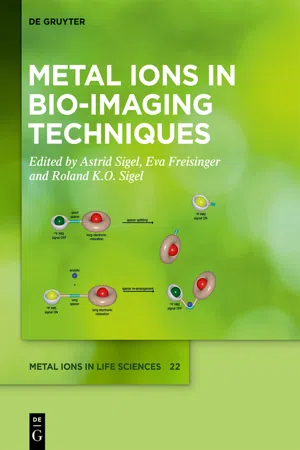
- 547 pages
- English
- ePUB (mobile friendly)
- Available on iOS & Android
Metal Ions in Bio-Imaging Techniques
About this book
Volume 22, entitled Metal Ions in Bio-Imaging Techniques, of the series Metal Ions in Life Sciences deals with metal ions as tools in imaging. This dates back to the first half of the past century, when barium sulfate was orally given to patients undergoing X-ray examination. The use of contrast agents has since developed into a large interdisciplinary field encompassing not only medicine, but also chemistry, material sciences, physics, biology, engineering, and computer sciences. MILS-22 provides deep and current insights in 17 stimulating chapters on the new research frontiers of this fast growing field on bio-imaging... and beyond. For example, adding bio-sensing yields theranostic agents, meaning diagnosis and therapy linked in the same molecule; ions of Gd, Mn, Fe, Co, Ir, 99m Tc, etc., are involved. Other important topics are, e.g., metal complexes in paramagnetic Chemical Exchange Transfer (paraCEST), radiometals for Positron Emission Tomography (PET) imaging, or paramagnetic metal ion probes for 19 F magnetic resonance imaging. MILS-22 is written by 57 internationally recognized experts from 12 countries, that is, from the US via Europe to China. The impact of this vibrant research area is manifested by more than 2300 references and nearly 120 figures, mostly in color, and several informative tables. To conclude, Metal Ions in Bio-Imaging Techniques is an essential resource for scientists working in the wide range from material sciences, enzymology, analytic, organic, and inorganic biochemistry all the way through to medicine including the clinic... not forgetting that also excellent information for teaching is provided.
Frequently asked questions
- Essential is ideal for learners and professionals who enjoy exploring a wide range of subjects. Access the Essential Library with 800,000+ trusted titles and best-sellers across business, personal growth, and the humanities. Includes unlimited reading time and Standard Read Aloud voice.
- Complete: Perfect for advanced learners and researchers needing full, unrestricted access. Unlock 1.4M+ books across hundreds of subjects, including academic and specialized titles. The Complete Plan also includes advanced features like Premium Read Aloud and Research Assistant.
Please note we cannot support devices running on iOS 13 and Android 7 or earlier. Learn more about using the app.
Information
1 Metal Ions in Bio-Imaging Techniques: A Short Overview
Abstract
1. Introduction
2. Magnetic Resonance Imaging/Magnetic Resonance Spectroscopy Probes
2.1. Recent Advances in Gadolinium-Based Probes
Table of contents
- Title Page
- Copyright
- Contents
- 1 Metal Ions in Bio-Imaging Techniques: A Short Overview
- 2 Gadolinium(III)-Based Contrast Agents for Magnetic Resonance Imaging. A Re-Appraisal*
- 3 Manganese Complexes as Contrast Agents for Magnetic Resonance Imaging
- 4 Metal Ion Complexes in Paramagnetic Chemical Exchange Saturation Transfer (ParaCEST)
- 5 Lanthanide Complexes Used for Optical Imaging
- 6 Radiometals for Positron Emission Tomography (PET) Imaging
- 7 99mTechnetium-Based Imaging Agents and Developments in 99Tc Chemistry
- 8 Paramagnetic Metal Ion Probes for 19F Magnetic Resonance Imaging
- 9 Iron Oxide Nanoparticles for Bio-Imaging
- 10 Magnetic Resonance Contrast Enhancement and Therapeutic Properties of Corrole Nanoparticles
- 11 Positron Emission Tomography (PET) Driven Theranostics
- 12 Magnetic Resonance Theranostics: An Overview of Gadolinium(III)-Based Strategies and Magnetic Particle Imaging
- 13 Luminescence Imaging of Cancer Cells
- 14 Iridium(III) Complexes in Bio-Imaging Including Mitochondria
- 15 Imaging Bacteria with Contrast-Enhanced Magnetic Resonance
- 16 Transition Metals and Imaging Probes in Neurobiology and Neurodegenerative Diseases
- 17 Heavy Elements for X-Ray Contrast
- Subject Index